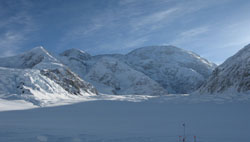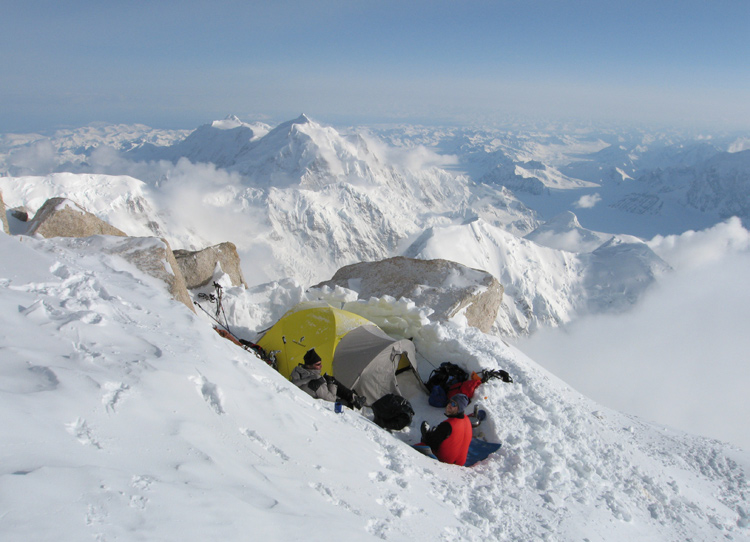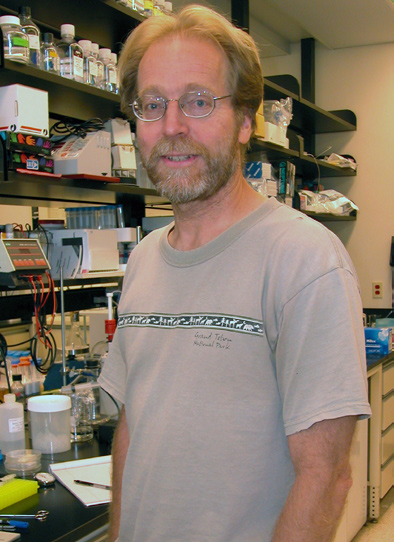| |
 |
|
|
|
|
| |
Denali from the southwest
Photo: Martin LeRoux |
|
Any sport has hazards. Climbers disappear down rock faces, snow slopes and crevasses. The mountain
sheds its skin in rock slides, ice falls and avalanches.
Weather gets radical. And there’s the invisible enemy: high-altitude sickness.
For Watts, Denali’s grandeur trumps the risk.
“Climbing is a wonderful activity,” he says. “You get to see the most dramatic countryside on the planet.”
A structural biologist, Watts has been mountaineering
for almost 20 years. He’s achieved summits
up to 23,000 feet and knows mountains with fierce and gorgeous names: Condorriri. Baruntse. Denali.
“Denali is the native name for Mt. McKinley,” Watts says. “It’s a serious mountain. You can make arguments that it’s the greatest.”
 |
On Denali’s West Rib, Dr. Norman Watts (l) with Martin le Roux at 16,200 feet, where Watts was forced to turn back: “My fellow climbers helped me out when I really needed it.”
Photo: Gordon Laurens |
At 20,320 feet, Denali is the highest peak in North America. Measured from sea level, Mt. Everest is taller. Compared to Everest base camp (b/c) at 17,000 feet, you fly to Denali b/c at 7,000 feet, and then climb about 13,000 feet. However, you fly in from an Alaskan village at only 360 feet, so the altitude gain is still pretty great, says Watts.
“And the air,” he adds, “is thinner at the poles.” This effect adds the equivalent of about 2,000 feet at the summit. Denali sits just south of the Arctic Circle, where it can host exceedingly high winds and temperatures of -40° in spring (the best time to climb).
In 1994, after his second postdoc and before joining NIH, Watts first encountered Denali. He made the summit.
“The second time [in 2000] we had to come down, because my friend got bronchitis. The third time [in spring 2008] I got high-altitude cerebral edema,
plus I was coming down with Lyme disease, although I didn’t know it at the time.” The double whammy forced him back.
Home is Montgomery County, near Sugarloaf Mountain. Watts is a Canadian from New Brunswick,
a maritime province. As a child, he traveled briefly to Alberta, where he glimpsed the Canadian
Rockies, then fell in love with mountains in the pages of National Geographic. “I thought, how do you get up on those things? First thing I did, post graduation from university, I bought climbing
gear.”
Expedition climbing ascends in stages. “You might have several camps with the higher camp supplied by the lower. Eventually someone will have a chance at the summit.”
At high altitudes, air pressure is lower and oxygen
thinner. To compensate, the body increases
breathing rate, heart rate and red blood cell production. “There are probably also changes in mitochondria,” Watts explains. “Energy production
genes get turned on.”
 |
Watts, back at the lab
Photo: Belle Waring |
High-altitude sickness is usually mild if the body has time to acclimatize, yet even the very fit can become ill from fluid shifts in the body. The brain can swell; the lungs can fill with fluid—
in essence, says Watts, “you begin to drown on dry land.”
Because high-altitude cerebral edema (HACE) is life-threatening, it’s one reason climbing Denali
takes 3 to 4 weeks: “You can’t just rush it,” Watts says.
But his team lost 3 full acclimatization days due to bad weather. They made camp at over 16,000 feet on the West Rib route where the terrain dropped off all around them. Then, says Watts, “I woke up and knew something was wrong. It was pretty clear I had HACE.”
Situation: urgent. “You have to get down far and fast because the brain swells,” he says. “It leads to confusion and ataxia—your coordination
goes—so my friends tied me on a short rope” to keep him from falling: “It’s necessary to give credit to my partners,” he stresses.
In almost 20 years, it was the first time he’d gotten HACE.
Even off the mountain, he felt “wobbly, unmotivated,
with a roaring fever. I took my first shower
in over 3 weeks and saw these curious bull’s-eye rashes—20 of them.”
Back home, his bloodwork showed Lyme disease,
a tick-borne illness. “I probably got it from my dogs before I left,” he says, “and developed it in that 3-week period.” Treated with antibiotics,
Watts responded well and returned to work, where he spotted a flyer for an NIH Lyme disease
research study. He joined at once.
Watts works with hepatitis and HIV proteins
in two NIAMS labs, the Protein Expression
Laboratory with Dr. Paul Wingfield and the Laboratory of Structural Biology Research with Dr. Alasdair Steven. “I’ve always been a pretty
academic person,” he says, “but I really love nature. So I get to do two exotic things: electron microscopy and mountaineering.”
He resists the notion that his adventures are heroic. More like—reflective. “When something
happens,” he says, “you gain insight about yourself.”
You gain perspective as your attention shifts from geology to microscopy. From athlete to patient. From bench scientist to research volunteer.
“There’s no way you can go out there and not be significantly affected,” he says. “There are reasons
people have thought of mountains as deities,
as the axis of the Earth.” 